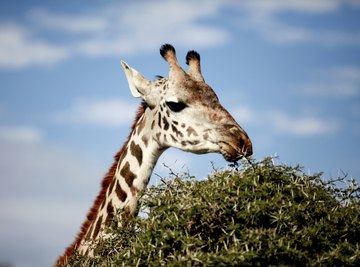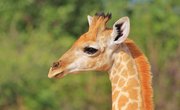
Scientists have identified nine subspecies of giraffe that live in different areas and are differentiated by their different patterns. Color variations between the species depend on their habitat as well as their food source. Giraffes can range in color from almost white to almost black, and while the specific patterns vary by species, all have the characteristic splotches that resemble leaves (or in the case of the reticulated giraffe, which has a dark coat, a web of white lines). Like human fingerprints, the patterns are unique to each animal.
TL;DR (Too Long; Didn't Read)
While giraffes sometimes eat grasses, fruits and vegetables, they eat mostly leaves. The leaves of the acacia tree are a particular favorite.
The world’s tallest land animal, the giraffe, is an herbivore that needs to be almost constantly chewing to ensure it gets necessary nutrients. In the wild, the typical giraffe diet is almost exclusively leaves, and the animal eats up to 75 pounds of them a day. In captivity, giraffes are fed leaves, some fruits, hay and vegetables, as well as specially designed giraffe food, often in pellet form.
Standing up to 19 feet tall, the giraffe has little competition for food; it can easily graze from high treetops that other animals can’t reach. Since the males tend to be taller, they eat from the higher branches, leaving the lower ones for the females.
The Giraffe Diet Includes a Favorite Leaf
Both in the wild and in captivity, giraffes show a preference for the leaves of the acacia tree. These trees have long thorns mixed in with the leaves that deter other animals, but giraffes are able to use their long tongues (measuring 18 to 20 inches) to maneuver around the thorns. Giraffes also have a built-in protection from their thorny meals: their thick, sticky saliva protects them from any thorns they may inadvertently swallow. While acacia leaves are a staple in their diet, they also eat the flowers when they are in season. The flowers have more tannin, but also twice the protein.
In the Serengeti, it has been noted that females tend to choose more herbs than males, with the female giraffe diet being richer in nutrients while the male giraffe diet is higher in fiber and lignin. This difference may help explain how females can produce young even in the dry season when food is not as plentiful.
Drinking Breaks Are Infrequent
Acacia leaves contain a good amount of water, so giraffes do not need to drink very often. In fact, they can go days without drinking water at all. This works to their benefit since their 6-foot legs and 6-foot neck make it difficult to bend down to reach water sources, making them vulnerable to predators. In the wild, giraffes tend to drink in groups, taking turns watching for predators. When water is plentiful (for example in captivity), they can drink up to 10 gallons a day.
Grazing Is Awkward
While leaves make up the majority of the giraffe diet (more than 90 percent in the wild), the animals do sometimes graze on grasses. But, like drinking from a watering hole, this presents a challenge. To reach the ground, they must spread their legs far apart and bend at the knee to reach food on the ground. In this position, they are vulnerable to predators, which may be why they prefer to eat food they can obtain at shoulder level or above. It is rare to see a solo giraffe grazing in this manner; this behavior is typically only seen in groups, which provide more safety.
They Chew All Day
Giraffes, like cows, are ruminants. Their stomachs have four compartments to digest their food. They chew up and swallow the leaves, which form a ball and travel back up the throat. They then continue to chew this cud before swallowing it again to continue the digestive process. Typical giraffe feeding habits provide a nice schedule. Since they tend to eat more in the morning and evening when it is cooler, they spend the heat of the day chewing on their cud.
Babies Grow up Fast
A baby giraffe, called a calf, starts life with a 5-foot drop to the ground. Within an hour, it is up on its feet and nursing from its mother. A giraffe calf may start to sample vegetation within its first week. In groups of giraffes, one female is designated the “babysitter” and watches over the calves as they learn to socialize. At four months, a baby giraffe starts to supplement its diet by eating leaves, but it continues to nurse until it is six to nine months old, at which time it adopts a typical giraffe diet.
References
About the Author
Kimberly Yavorski is a freelance writer with a passion for learning, especially about nature, outdoors and the natural sciences. A longtime student of the life sciences, she served as a leader for Girl Scouts and 4H, sharing her interests by teaching children and teens about natural and environmental science and animal anatomy. Her work has also appeared on LetsGetOutside.us and Happy Science Mom. She can be found at www.kimberlyyavorski.com.
Photo Credits
Chestertonjp/iStock/Getty Images
